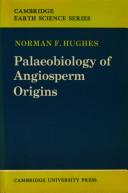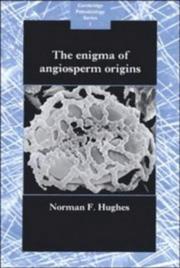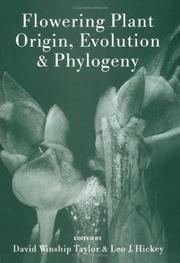| Listing 1 - 10 of 13 | << page >> |
Sort by
|

ISBN: 0521208092 9780521208093 Year: 1976 Publisher: Cambridge : Cambridge University Press,
Abstract | Keywords | Export | Availability | Bookmark
 Loading...
Loading...Choose an application
- Reference Manager
- EndNote
- RefWorks (Direct export to RefWorks)
Angiosperms, Fossil --- Paleobotany --- Angiosperms, Fossil. --- Paleobotany - Mesozoic
Book
ISBN: 9780521592833 0521592836 9780511980206 9780521597067 9781139116084 1139116088 9781139126748 1139126741 0511980205 9781139113915 1139113917 9781139113915 9781139496384 1139496387 1107216273 9781107216273 1283295415 9781283295413 1139121820 9781139121828 9786613295415 6613295418 1139111728 9781139111720 1139123920 0521597064 9781139123921 Year: 2011 Publisher: Cambridge : Cambridge University Press,
Abstract | Keywords | Export | Availability | Bookmark
 Loading...
Loading...Choose an application
- Reference Manager
- EndNote
- RefWorks (Direct export to RefWorks)
"The recent discovery of diverse fossil flowers and floral organs in Cretaceous strata has revealed astonishing details about the structural and systematic diversity of early angiosperms. Exploring the rich fossil record that has accumulated over the last three decades, this is a unique study of the evolutionary history of flowering plants from their earliest phases in obscurity to their dominance in modern vegetation. The discussion provides comprehensive biological and geological background information, before moving on to summarise the fossil record in detail. Including previously unpublished results based on research into Early and Late Cretaceous fossil floras from Europe and North America, the authors draw on direct palaeontological evidence of the pattern of angiosperm evolution through time. Synthesising palaeobotanical data with information from living plants, this unique book explores the latest research in the field, highlighting connections with phylogenetic systematics, structure and the biology of extant angiosperms"
Angiosperms, Fossil. --- Angiosperms --- Evolution. --- Flowering plants --- Magnoliophyta --- Phanerogams --- Plants, Fossil
Book
ISBN: 3924500525 9783924500528 Year: 1989 Publisher: Frankfurt am Main : Senckenbergische naturforschende Gesellschaft,
Abstract | Keywords | Export | Availability | Bookmark
 Loading...
Loading...Choose an application
- Reference Manager
- EndNote
- RefWorks (Direct export to RefWorks)
Monocotyledons, Fossil. --- Paleobotany --- Eocene Epoch --- Fossil botany --- Palaeobotany --- Botany --- Paleontology --- Angiosperms, Fossil --- Monographic series --- Monocotyledons, Fossil
Book
ISBN: 1283160641 9786613160645 9047424026 Year: 2008 Publisher: Sofia, Bulgaria : Leiden ; Boston : Pensoft Publishers ; Brill,
Abstract | Keywords | Export | Availability | Bookmark
 Loading...
Loading...Choose an application
- Reference Manager
- EndNote
- RefWorks (Direct export to RefWorks)
Paleontologists just recently opened their eyes to the wealth of fossil documents relevant to plant – arthropod interaction and are busy now accumulating raw data. Perhaps the richest regional collection of interaction traces came from the mid-Cretaceous deposits of the Negev Desert, Israel, encompassing the time interval of the rise and basal radiation of angiosperms – the flowering plants. The arthropods (insects and mites) inserting their eggs in the leaves and making leaf mines and galls were discovering new possibilities for endophytic life that the flowering plants provided. Their morphological disparity suggests a diversification race, in which the angiosperms failed to override their leaf parasites. Only a small fraction of insect diversity is represented by body fossils that belong to one extinct and nine extant families of beetles and cockroaches mostly. Because similar structures are produced on leaves by parasitic arthropods of different systematic alliances, a purely morphological classification is worked out for the trace fossils, with but tentative assignments to natural taxa, referring to distinct types of parasitic behavior. It is the Evolution of behavior that is documented by the trace fossils. The body fossils and parasitic traces represent morphologies and behavioral traits fairly advanced for their geological age. The expression, abundance, co-occurrence, and host specialization of parasitic structures, as well as the marks of predation on mines and galls betray regulatory mechanisms of plant – arthropod interaction, analyzed in the broad context of ecosystem evolution, paleogeography and climate change. Co-published by Pensoft Publishers andamp; Brill Academic Publishers
Angiosperms, Fossil --- Arthropoda, Fossil --- Insect-plant relationships --- Insects, Fossil --- Paleontology --- Trace fossils
Book
ISBN: 0198577117 Year: 1989 Publisher: Oxford : Clarendon Press,
Abstract | Keywords | Export | Availability | Bookmark
 Loading...
Loading...Choose an application
- Reference Manager
- EndNote
- RefWorks (Direct export to RefWorks)
Dicotyledons --- -Dicotyledons --- -Dicotyledons, Fossil --- -#WPLT:syst --- Angiosperms, Fossil --- Dicots --- Dicotyledoneae --- Dicotyledones --- Dicotyls --- Magnoliopsida --- Angiosperms --- Classification --- -Congresses --- Evolution --- Congresses --- -Classification --- HAMAMELIDAE --- PHYLOGENESIS --- FOSSILS --- MEETINGS --- EVOLUTION --- SYSTEMATICS
Book
ISBN: 3642011608 3642011616 Year: 2010 Publisher: Berlin ; Heidelberg : Springer-Verlag,
Abstract | Keywords | Export | Availability | Bookmark
 Loading...
Loading...Choose an application
- Reference Manager
- EndNote
- RefWorks (Direct export to RefWorks)
This book, besides providing necessary background information and discussions, focuses on the earliest angiosperms: namely those more than 125 million years old. Currently 125 million year old angiosperms, are the oldest to be found - especially in the eyes of European scholars. It proceeds by introducing several interesting angiosperms from the Jurassic and early Cretaceous, including Schmeissneria (early-middle Jurassic, 160-199 million years old (Ma)), Xingxueanthus (middle Jurassic, 160 Ma), Solaranthus (middle Jurassic, 164 Ma), Callianthus (early Cretaceous, 125 Ma), Chaoyangia (early Cretaceous, 125 Ma), Archaefructus (early Cretaceous, 125 Ma), Sinocarpus (early Cretaceous, 125 Ma). Others are currently being processed. These fossils, most of which have hitherto not been published,will uncover many unknown aspects of early angiosperms, and help to solve the mystery surrounding their origin.
Angiosperms, Fossil --- Angiosperms --- Paleobotany --- Geology --- Biology --- Earth & Environmental Sciences --- Health & Biological Sciences --- Biology - General --- Origin --- History. --- Evolution. --- Flowering plants --- Magnoliophyta --- Earth sciences. --- Geobiology. --- Earth Sciences. --- Biogeosciences. --- Phanerogams --- Earth sciences --- Biosphere --- Geosciences --- Environmental sciences --- Physical sciences

ISBN: 0521411459 Year: 1994 Publisher: Cambridge ; New York, NY : Cambridge University Press,
Abstract | Keywords | Export | Availability | Bookmark
 Loading...
Loading...Choose an application
- Reference Manager
- EndNote
- RefWorks (Direct export to RefWorks)
The origins of angiosperms are still debated, despite many years of work by scientists from differing disciplines. The progress made toward resolving the problem is reviewed in this book. The author suggests that the only fruitful method of study is the total integrated use of the fossil record, particularly dispersed palynomorphs. This includes the use of electron microscopy and refined data handling to record the occurrence of microscopic fossils, rather than the extensive use of morphology and cladistics. The methods advocated in this book could result in a rethink of the current classification of living plants. The ideas presented will initiate discussion between both professionals and students of palaeontology and plant science on the wider possibilities that may clarify the enigmatic origins of the dominant flowering plant groups.
561 --- 582.5 --- 561.5 --- Angiosperms, Fossil --- Paleobotany --- -Fossil botany --- Palaeobotany --- Botany --- Paleontology --- Plants, Fossil --- Systematic palaeobotany --- Angiospermae. Metaspermae. Stigmateae. Covered-seed plants. Later seed plants --- Angiospennae (Metaspennae. Stigmateae) --- Angiosperms, Fossil. --- PAL Paleontology & Palynology --- Angiospermae = Angiosperms --- Paleontology & Palynology --- palaeobotany --- -Systematic palaeobotany --- 561.5 Angiospennae (Metaspennae. Stigmateae) --- 582.5 Angiospermae. Metaspermae. Stigmateae. Covered-seed plants. Later seed plants --- 561 Systematic palaeobotany --- -561.5 Angiospennae (Metaspennae. Stigmateae) --- Fossil botany --- Mesozoic Era --- ANGIOSPERMS --- ORIGIN --- FOSSILS --- PALEOBOTANY
Book
ISBN: 0231038577 Year: 1976 Publisher: New York, NY ; London : Columbia University Press,
Abstract | Keywords | Export | Availability | Bookmark
 Loading...
Loading...Choose an application
- Reference Manager
- EndNote
- RefWorks (Direct export to RefWorks)
Angiosperms --- -Angiosperms --- -Angiosperms, Fossil --- -582.5 --- 561.5 --- 575.86 --- Plants, Fossil --- Flowering plants --- Magnoliophyta --- Phanerogams --- Evolution --- -Congresses --- Origin --- Congresses --- Angiospermae. Metaspermae. Stigmateae. Covered-seed plants. Later seed plants --- Angiospennae (Metaspennae. Stigmateae) --- Origin of groups of organisms (taxa). Phylogeny --- Angiosperms, Fossil --- Congresses. --- SYS General Systematics --- duplicates available --- Angiospermae = Angiosperms --- evolution --- general systematics --- palaeobotany --- 575.86 Origin of groups of organisms (taxa). Phylogeny --- 561.5 Angiospennae (Metaspennae. Stigmateae) --- 582.5 Angiospermae. Metaspermae. Stigmateae. Covered-seed plants. Later seed plants --- 582.5 --- Evolution&delete& --- Origin&delete&

ISBN: 0412053411 0585230951 Year: 1996 Publisher: New York, N.Y. Chapman & Hall
Abstract | Keywords | Export | Availability | Bookmark
 Loading...
Loading...Choose an application
- Reference Manager
- EndNote
- RefWorks (Direct export to RefWorks)
Contributors ix Chapter Introduction: The Challenge of Flowering Plant History David Winship Taylor and Leo J. Hickey Chapter 2. A Survey of Reticulate Venation Among Fossil and Living Land Plants Mary Louise Trivett and Kathleen B. Pigg Chapter 3. A New Gnetophyte from the Late Carnian (Late Triassic) of Texas and its Bearing on the Origin of the Angiosperm Carpel and Stamen 32 Bruce Cornet Chapter 4. Wood Anatomy of Primitive Angiosperms: New Perspectives and Syntheses 68 Sherwin Carlquist Chapter 5. Evidence for the Earliest Stage of ~giosperm Pollen Evolution: A Paleoequatodal Section from Israel 91 Gilbert J. Brenner Chapter 6. The Origin and Evolution of the Angiosperm Carpel 116 David Winship Taylor and Gretchen Kirchner Chapter Floral Structure, Development, and Relationships of Paleoherbs: Saruma, Cabomba, Lactoris, and Selected Piperales 141 Shirley Tucker and Andrew Douglas Chapter 8. Origin of the Angiosperm Flower 176 Leo J. Hickey and David Winship Taylor Chapter Evidence for and Implications of an Herbaceous Origin for Angiosperms 232 David Winship Taylor and Leo Z Hickey Chapter Comparison of Alternative Hypotheses for the Origin of the Angiosperms 267 Henry Loconte 10. 9. W. C. 7. 1. CONTENTS vi Contents Chapter The Least Specialized Angiosperms 286 Robert F. Thorne Chapter Molecular Phylogenies and the Diversification of the Angiosperms 314 Kenneth J. Sytsma and David A. Baum 341 References Appendix. Stratigraphic Time Scale 387 Index 12. 11.
Angiosperms --- Angiosperms, Fossil --- Evolution --- Congresses. --- Origin --- Plant genetics. Plant evolution --- Palaeobotany --- Phanerogams --- 582.5 --- 575.86 --- -Angiosperms --- -Angiosperms, Fossil --- -582.5 --- 575.86 Origin of groups of organisms (taxa). Phylogeny --- Origin of groups of organisms (taxa). Phylogeny --- 582.5 Angiospermae. Metaspermae. Stigmateae. Covered-seed plants. Later seed plants --- Angiospermae. Metaspermae. Stigmateae. Covered-seed plants. Later seed plants --- Plants, Fossil --- Flowering plants --- Magnoliophyta --- -Congresses --- Congresses --- Life sciences. --- Paleontology. --- Evolutionary biology. --- Plant physiology. --- Life Sciences. --- Plant Physiology. --- Evolutionary Biology. --- Evolution&delete& --- Origin&delete& --- Evolution (Biology). --- Paleontology . --- ANGIOSPERMS --- ORIGIN --- PHYLOGENY --- MEETINGS --- EVOLUTION --- Plant ecology. Plant sociology
Book
ISBN: 0521323576 9780521323574 Year: 1985 Publisher: Cambridge : Cambridge University Press,
Abstract | Keywords | Export | Availability | Bookmark
 Loading...
Loading...Choose an application
- Reference Manager
- EndNote
- RefWorks (Direct export to RefWorks)
-Paleontology --- -Fossilogy --- -Angiospermae. Metaspermae. Stigmateae. Covered-seed plants. Later seed plants --- Angiosperms, Fossil --- Angiosperms --- Paleontology --- 575.86 --- 582.5 --- 575.86 Origin of groups of organisms (taxa). Phylogeny --- Origin of groups of organisms (taxa). Phylogeny --- 582.5 Angiospermae. Metaspermae. Stigmateae. Covered-seed plants. Later seed plants --- Angiospermae. Metaspermae. Stigmateae. Covered-seed plants. Later seed plants --- Fossilogy --- Fossilology --- Palaeontology --- Paleontology, Zoological --- Paleozoology --- Historical geology --- Zoology --- Fossils --- Prehistoric animals in motion pictures --- Flowering plants --- Magnoliophyta --- Phanerogams --- Plants, Fossil --- Congresses --- Congresses. --- Angiosperms, Fossil - Congresses --- Angiosperms - Congresses --- Paleontology - Cretaceous - Congresses --- Paleontology - Tertiary - Congresses --- PALEONTOLOGIE VEGETALE --- PHYLOGENESE
| Listing 1 - 10 of 13 | << page >> |
Sort by
|

 Search
Search Feedback
Feedback About UniCat
About UniCat  Help
Help News
News